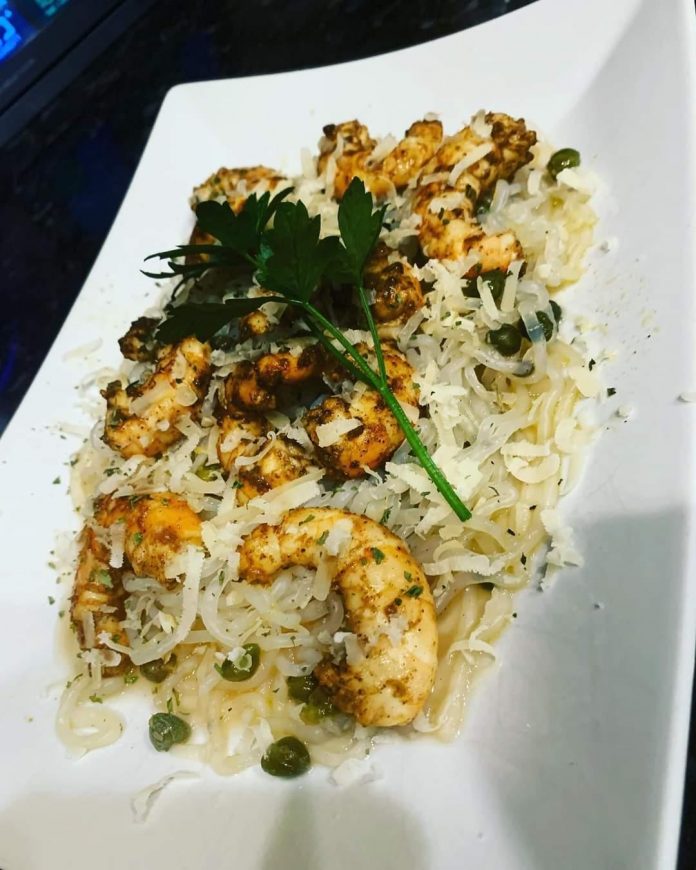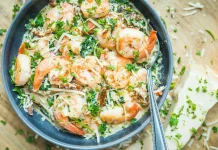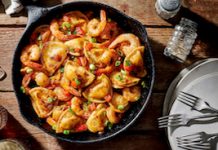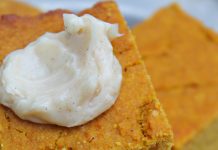2023 Static Media®. All Rights Reserved
The Unexpected Creamy Ingredient That Can Replace Cocktail Sauce
Beyhanyazar/Getty Images
BY STEPHANIE FRIEDMAN/AUG. 16, 2023 6:30 PM EST
At buffets, parties, and restaurants, classic shrimp cocktail is usually made of cooked seafood with a potent red sauce. Typically, you’ll find ingredients like ketchup, horseradish, Worcestershire sauce, lemon juice, chili powder, and sugar, which create a mix of sweet, spicy, and sour flavors that pair well with the shrimp. But if you’re not a fan of tomato-based condiments with your seafood, there is an often overlooked (but just as delicious) alternative you can try.
If you have Thousand Island dressing, you have all you need to make a perfect shrimp cocktail. Unlike the spicier red sauce, you’ll get a thicker condiment from the mayo in Thousand Island — and based on dips like tartar sauce and remoulade, we know that creamy ingredients work well with seafood. But with the dressing, you’ll also get sweetness from the relish, acidity from the apple cider vinegar, and a little bite from the red onion and garlic. Plus, it typically still includes a little ketchup, although the flavor won’t be as overpowering. You can either buy a bottle or make it yourself, depending on your tastebuds and preferences.
Build your own Thousand Island dipping sauce
Hector Ruiz/Shutterstock
Shrimp cocktail isn’t the only place you can use Thousand Island dressing — flavors pair so well that it’s often used on top of shrimp salads. One version in particular, called shrimp Louie, incorporates boiled eggs, iceberg lettuce, and occasionally crab. But when you’re going with a shrimp cocktail, you’ll likely want to poach your seafood, as is done when preparing the classic version of the dish. This means you’ll cook it in a seasoned liquid at medium temperature until done.
If you’re making your own version of Thousand Island dressing, there are a few variations you can include. Instead of apple cider vinegar, you can use almost any other type you like: red wine, champagne, white wine, or distilled white vinegar will all work. Instead of relish, you can substitute sweet chopped pickles, or dill ones if you’d like less of a sugary taste. Feel free to add any complimentary ingredients like capers, chopped gherkins, lemon juice, and fresh dill, or spices like chili powder, paprika, or a few dashes of your favorite hot sauce. And if you’re not a pickle fan, you can omit the flavor entirely and use the rest of the ingredients to make Marie Rose sauce, a British condiment that’s been used for shrimp cocktail since the 1960s. While this creamy shrimp dip may be unexpected, it’s a combination that’s been around for decades and is easy to make on your own.
RECOMMENDED
Unusual Cookbooks For Chefs Who Really Hate Cooking
The Fast Food Place With The Best Pancakes Might Surprise You
Man V Food Challenges We Can’t Stop Thinking About
Avoid These Mayonnaise Brands At All Cost
NEXT UP
Common Mistakes Everyone Makes With Shrimp
Poring Studio/Shutterstock
BY BRIAN ROONEY/UPDATED: JULY 8, 2022 1:16 PM EST
We’ve all heard from it Bubba in “Forrest Gump”: shrimp is the fruit of the sea. As he says, you can barbecue it, boil it, broil it, bake it, sauté it, and so on. Shrimp is a lean, nutritious, and versatile protein option that can make any occasion — from routine weeknight dinners to large family get-togethers — exciting and fresh.
Not only is shrimp notoriously versatile, but it also brings a plethora of health benefits. According to Healthline, shrimp only contains 84 calories per 3-ounce serving, but simultaneously provides a wide range of nutrients such as a high protein count, iron, potassium, and zinc. Plus, shrimp is an excellent source of iodine, a mineral that aids in thyroid and brain health.
Shrimp is also generally inexpensive. While it does come in a variety of forms, you can find easily accessible options at the seafood counter in a grocery store or at a local fishmonger. And cooking shrimp is a straightforward task — it takes well to marinades and seasonings, and is an easy way to bring some extra flavor and new textures to a simple dish.
But shrimp, like most seafood, can be temperamental. There are a number of factors to consider when buying, preparing and cooking shrimp that can make or break your final dish. Here are the most common mistakes to avoid to help you get the most out of the shrimp you’ve picked out.
Buying old shrimp
leonori/Shutterstock
First thing’s first: you have to pick out your shrimp. But it’s not as simple as you may think. Any shrimp that’s been left out too long can spoil your cooking plans.
The best way to make sure you are buying fresh shrimp is to examine it before purchase. Fresh shrimp appears translucent and should be firm and shiny. Any shrimp with discoloration or that appears dull and flimsy should be avoided. Feeling and touching shrimp is another way to test its freshness. Any shrimp that is slimy or sticky instead of glossy has gone bad. The same goes for shrimp with any foul smell — fresh shrimp should not smell very fishy. However, a mild saltiness reminiscent of the ocean is a good sign.
Not being able to tell whether your shrimp is good to consume could ruin the plans you’ve made for them and also be harmful to your health. Illnesses related to consuming bad shellfish can lead to symptoms such as nausea and vomiting, as well as stomach pains. Once you have picked out fresh shrimp, it should always be refrigerated until ready to use and then cooked sooner rather than later. Shrimp can last between one or two days in the refrigerator, but no more than a couple of hours outside it.
Picking out the wrong type of shrimp
Phensri Ngamsommitr/Shutterstock
Although you may not have given much thought to the types of shrimp available at your local supermarket, there is a wide variety of shrimp out there, all of which are at their best during different times of the year.
White shrimp are the most accessible and widely available. They’re super versatile and are ready to be enjoyed all year round. Other shrimp include rock shrimp, banana shrimp, Atlantic Northern shrimp, tiger shrimp, and many others that bring different flavors and uses to your plate. While your supermarket may only have one or a couple of types of shrimp available for purchase, a local fishmonger is sure to have a wide variety to choose from and try out.
Another key difference when deciding which shrimp to buy is whether they are farmed or wild. If you are keen to consider the sourcing of the food you buy and eat, the differences should be noted. The operation of shrimp farms includes the clearing of coastal habitats which removes protection from hurricanes and other storms. Plus, antibiotics are often used in farming, which contributes to sustainability issues and alters the taste.
Wild shrimp feed on their natural diet, which arguably makes them taste better. However, catching wild shrimp does contribute to overfishing and bycatch. But improvements with nets are helping reduce bycatch and keeping other species from being caught.
Not thawing properly
CGN089/Shutterstock
Because shrimp turns bad relatively quickly, a good way to keep it fresh is to freeze it. If you buy shrimp during your weekly trip to the market but don’t plan on using it for a few days, putting it in the freezer will ensure that it will not go bad before it’s time to cook. Don’t be fooled by their size, though — thawing them out takes more time than you might think. Also, defrosting them using warm water or the microwave is not the way to go.
Shrimp cooks quickly. So quickly, in fact, submerging frozen shrimp in water or defrosting them in the microwave will trigger the cooking process prematurely. Then, when it’s time to actually cook the shrimp, they will be more susceptible to overcooking as well as uneven cooking.
The best way to make sure your shrimp is completely thawed out and remains raw before hitting the heat is to remove them from the freezer the day before and place them inside a colander set in a bowl. As the shrimp defrosts, the water will drain out and keep your shrimp from getting soggy. If you suddenly find yourself in need of cooked shrimp, securing them in an airtight bag and submerging them in cold water will thaw out your shrimp in 10 to 20 minutes.
Not using skewers when grilling
Oksana Mizina/Shutterstock
Your backyard grill is one of the best cooking tools you have, yet many people do not utilize their grill to its full potential. Grilling hamburgers and hot dogs every time you light up your grill can get tired no matter how delicious they are. Grilling shrimp is an easy and delicious way to bring something new to the backyard cookout and also keep the protein lean and light.
Once you have prepped your shrimp according to your recipe, loosely tossing them on the grill can be dangerous. Most shrimp are quite small, and the slightest motion with your barbecue tongs can knock a piece of shrimp sideways and down between the grates. The best way to avoid this is to simply spear them with skewers (pre-soaked, of course). Holding all of your shrimp together firmly and neatly will make cooking them a breeze and will ensure an even char. You’ve paid for your shrimp, prepped, and seasoned them — it’d be a shame to lose any to the flames.
Removing the shells before cooking
Pietruszka/Shutterstock
Peeling and tossing the shells may seem like typical shrimp protocol, but there are benefits to keeping the shells on for cooking. Because shrimp cooks exceptionally fast, leaving the shells on can protect the shrimp from overcooking or cooking unevenly when grilling or broiling. Not only does leaving the shells on save prep time, but it will also usually yield a more tender, juicier final product as well as an enhanced shrimp flavor.
Don’t take it from us, though. Take it from world-class chef and Travel Channel icon, Andrew Zimmern. He believes the shells on shrimp act as a natural heat buffer as well as provide another layer of distinct shrimp flavor. When cooking larger-sized shrimp (such as jumbo), this heat buffer protects the inner portion of the shrimp from finishing before the outer. The result is not only an evenly cooked piece of shrimp but a more intensely flavored one as well.
Not deveining properly
v2pham/Shutterstock
Of all the prep required for cooking shrimp, deveining is the most essential. While you can buy shrimp that has already been cleaned, buying fresh shrimp is always a better option. Therefore, you should know how to clean them yourself.
Although removing the veins may seem like a time-consuming, unnecessary task, it is important to do. The vein is the shrimp’s digestive tract and contains its undigested food as well as its digested waste. Eating the vein is not harmful in any way, but leaving the vein inside the shrimp will result in a gritty texture as well as a not-so-appetizing thought while trying to enjoy them.
Once you have removed the opened shell to access the vein, simply use a small knife to shallowly slice, edge-to-edge, the back of the shrimp. The vein could be transparent, dark, or not there at all. If there is a vein, slide the tip of your knife underneath it and pull it out.
Skipping the brine
Foodio/Shutterstock
Brining is a practice usually associated with proteins like chicken or large cuts of pork. But you can brine shrimp as well, and the results take the shrimp’s tenderness and juiciness to a whole new level. According to Cook The Story, brining simply means soaking food in a salty solution ahead of cooking. Brines can be enhanced with ingredients such as herbs, spices, sugar, or all of the above. The food in the brine absorbs the liquid, making it juicier and more flavorful as it absorbs some of the salt.
The most simple brine you can make is a combination of water and salt. As previously stated, you can bring other flavors to the brine or just season the shrimp however you like after post-brine. Because shrimp have a smaller surface area, brining for any longer than one hour really isn’t necessary (unlike larger cuts of meat that can be brined for over a day).
One essential tip: don’t rinse shrimp after removing them from the brine. Simply pat them dry with a paper towel before seasoning or cooking. Rinsing the shrimp will remove the salt the shrimp have accumulated in the brine. Patting them dry is also essential, especially when pan-searing or grilling. The drier the shrimp, the more intense the Maillard reaction you’ll get, resulting in a crustier exterior.
Discarding the shells
Mironov Vladimir/Shutterstock
If you decide to remove the shells from your shrimp, tossing them in the trash is a missed opportunity. Saving your shrimp shells will provide you with a flavor-packed ingredient for a great stock. Shrimp shells are full of flavorful sugars that can be easily extracted in a pot of water. Shrimp stock is similar to fish stock but is much sweeter, which makes it an excellent foundation for soups and stews.
Using your hollow shrimp shells to make stock is easy. Simply bring a pot of water to a boil, add some aromatics such as lemon, onion, peppercorns, and parsley (all of which compliment seafood), and then add the shells. From there, the shells only need about 10 minutes in the pot for all of their sugars to release. Not only does utilizing your shells make for a more sustainable home kitchen, but using the shells to make stock gives you even more value out of your purchase.
Overcooking your shrimp
from my point of view/Shutterstock
The biggest mistake people make when preparing shrimp is cooking it for too long. Shrimp is not like beef or chicken (or even other seafood). Normally, you can tell a protein is done cooking based on its color, but shrimp turn pink and stay pink whether it’s perfectly done or overcooked.
The most accurate way to make sure your shrimp don’t need any more time on the heat is to use a thermometer. An internal temperature of 165 degrees F is the tipping point for perfect shrimp. If you do not have access to a thermometer, you can tell shrimp are done based on their shape. As shrimp cooks, it curls. Once the shrimp have curled into the shape of a letter “C,” they are done. This is not as precise as using a thermometer, but it is still a good measurement. If the shrimp curl all the way to resembling a letter “O,” you have unfortunately passed the point of no return.
Shrimp only takes about two to three minutes to reach that perfect temperature, so the best way to avoid overcooking them is to carefully watch your pan. Once the shrimp hit the heat, wait patiently and attentively with your thermometer in hand and examine their progress until it’s time.
- Jay Mastry - March 26, 2024
- Captains Corner, Gorta - March 23, 2024
- Dave Zalewski - March 12, 2024











